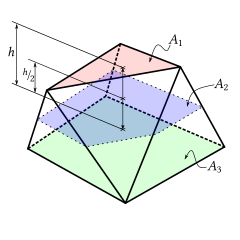Prismatoid

Ingeometry,aprismatoidis apolyhedronwhoseverticesall lie in two parallelplanes.Its lateral faces can betrapezoidsortriangles.[1]If both planes have the same number of vertices, and the lateral faces are eitherparallelogramsor trapezoids, it is called aprismoid.[2]
Volume
[edit]If the areas of the two parallel faces areA1andA3,the cross-sectional area of the intersection of the prismatoid with a plane midway between the two parallel faces isA2,and the height (the distance between the two parallel faces) ish,then thevolumeof the prismatoid is given by[3] This formula follows immediately byintegratingthe area parallel to the two planes of vertices bySimpson's rule,since that rule is exact for integration ofpolynomialsof degree up to 3, and in this case the area is at most aquadratic functionin the height.
Prismatoid families
[edit]| Pyramids | Wedges | Parallelepipeds | Prisms | Antiprisms | Cupolae | Frusta | ||
|---|---|---|---|---|---|---|---|---|

|

|

|

|

|

| |||
Families of prismatoids include:
- Pyramids,in which one plane contains only a single point;
- Wedges,in which one plane contains only two points;
- Prisms,whose polygons in each plane are congruent and joined by rectangles or parallelograms;
- Antiprisms,whose polygons in each plane are congruent and joined by an alternating strip of triangles;
- Star antiprisms;
- Cupolae,in which the polygon in one plane contains twice as many points as the other and is joined to it by alternating triangles and rectangles;
- Frustaobtained bytruncationof a pyramid or a cone;
- Quadrilateral-facedhexahedralprismatoids:
- Parallelepipeds– sixparallelogramfaces
- Rhombohedrons– sixrhombusfaces
- Trigonal trapezohedra– six congruent rhombus faces
- Cuboids– six rectangular faces
- Quadrilateral frusta– anapex-truncatedsquare pyramid
- Cube– six square faces
Higher dimensions
[edit]
In general, apolytopeis prismatoidal if its vertices exist in twohyperplanes.For example, in four dimensions, two polyhedra can be placed in two parallel 3-spaces, and connected with polyhedral sides.
References
[edit]- ^Kern, William F.; Bland, James R. (1938).Solid Mensuration with proofs.p. 75.
- ^Alsina, Claudi; Nelsen, Roger B. (2015).A Mathematical Space Odyssey: Solid Geometry in the 21st Century.The Mathematical Association of America.p. 85.ISBN9780883853580.
- ^Meserve, B. E.; Pingry, R. E. (1952). "Some Notes on the Prismoidal Formula".The Mathematics Teacher.45(4): 257–263.JSTOR27954012.
External links
[edit]

